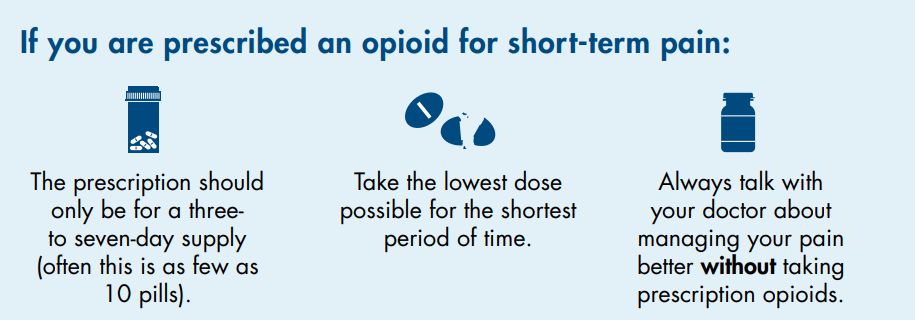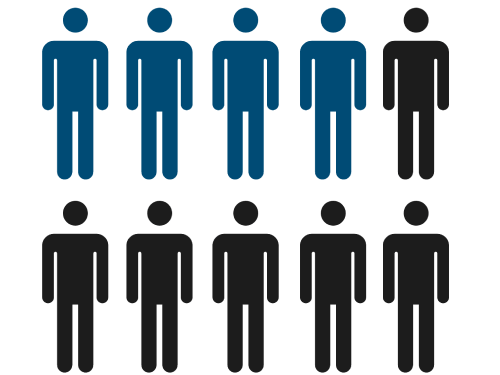Prevent Addiction
Opioid-based medications can be useful for pain management—especially for the severe pain someone may experience directly after surgery. However, opioid medications such as Vicodin®, Percocet® and OxyContin®, are powerful and can be deadly if not taken properly. Even if taken as directed, any opioid-based medication can have serious side effects, including addiction and overdose.
Consider Other Pain Management Options
“Adults and kids should understand that it’s not a victory to come out of the doctor’s office with opioids.”
–Dr. Caleb Banta-Green
Opioids aren’t the only painkillers on the market, and they’re not always the best way to fight pain. Talk to your doctor about ways to manage pain that do not involve prescription opioids. Some of these options may work better and have fewer risks and side effects. Depending on the type of pain you are experiencing, options may include:
- Over-the-counter pain relievers such as Acetaminophen (Tylenol®) or ibuprofen (Advil®)
- Physical therapy, acupuncture, chiropractic care, biofeedback, massage therapy, hypnotherapy
- Exercise including yoga, tai chi, swimming, etc.
- Relaxation therapy including meditation, breathing exercises, etc.
- Professional help coping with the emotional effects of pain (i.e., cognitive behavioral therapy)
When Opioids are Prescribed
It is important to talk to your health care provider about other medications you are taking and whether you have a history of substance misuse. This information will allow your provider to help you find a pain management plan that is not only effective, but safe.

*If you are using opioids for chronic pain or struggling with opioid dependence/addiction, ask your health care provider about keeping naloxone on hand.
Know about Dangerous Drug Interactions
Are you using prescription or illicit opioids? Many drugs have the potential to interact negatively with opioid medications.
EXAMPLE: Benzodiazepines, a class of psychoactive drugs including Xanax and Valium, are often prescribed for anxiety and insomnia. When benzodiazepines are combined with opioids, the risk of experiencing an overdose drastically increases. This is because both types of medications suppress bodily functioning. When mixed, these medications may lead to slowed or stopped breathing, decreased heart rate, and risk of death. Alcohol acts in a similar way. Therefore, it is recommended to restrict alcohol use while taking opioids.
Additional examples of medications that may negatively interact with opioids include:
| Anti-seizure medications, such as carbamazepine (Carbatrol®, Tegretol®, others), topiramate (Topamax®, Qudexy XR®, others) and lamotrigine (Lamictal®) |
| Certain antibiotics, including clarithromycin |
| Certain antidepressants |
| Certain antifungals, including itraconazole (Onmel®, Sporanox®, Tolsura®), voriconazole (Vfend®) and ketoconazole |
| Certain antiretroviral drugs used for HIV infection, including atazanavir (Reyataz®), indinavir (Crixivan®) and ritonavir (Norvir®) |
| Drugs for sleeping problems, such as zolpidem (Ambien®, Edluar®, others), eszopiclone (Lunesta®) and zaleplon (Sonata®) |
| Drugs used to treat psychiatric disorders, such as haloperidol (Haldol®), clozapine (Clozaril®, Versacloz®), aripiprazole (Abilify®) and quetiapine (Seroquel®) |
| Medications used to treat certain types of nerve pain, such as gabapentin (Neurontin®, Gralise®) and pregabalin (Lyrica®) |
| Muscle relaxers, such as cyclobenzaprine (Amrix®) and baclofen |
Both prescription and over-the-counter medications have been shown to produce adverse health effects when mixed with opioids. Know your medications, and the potential for life-threatening drug interactions. Talk with your doctor or pharmacist about your medications and be honest when they ask about your current drug/medication use.
Find a New Provider if Needed
You should feel comfortable talking to a health care provider about your pain management plan. If you are uncomfortable, or your provider insists on prescribing opioids, you may want to consider looking for a new provider. Ask friends or family members for recommendations, call your insurance company for a list of local providers, or visit the Washington State Health Care Authority website.
If you believe your provider has violated a law or has demonstrated unprofessional conduct/actions that misled or harmed you, another option is to file a complaint with the Washington State Department of Health.

Questions or concerns regarding speaking to your health care provider? We are here to help!
Talk to your Kids
Parent and other caregivers play an important role in preventing substance misuse among youth. Talking with youth about how to make safe, smart choices regarding drugs and alcohol is important. It is also important to acknowledge the risks of prescription drug use. Two-thirds of teens who misused pain relievers in the past year say that they got them from family and friends, including their home’s medicine cabinets, making it important to safeguard medicine in the home, according to the Partnership for Drug-Free Kids.
Start the Conversation Early
Parents can start as early as preschool when it comes to talking about medication use. If your child takes vitamins, this is a great way to introduce the topic. Explain that vitamins are medicine too; while they are good for you and help you grow, they can also be harmful if you take too many. Being transparent about your own medication use reminds children that medications are taken for a specific reason and not for fun.

It is crucial that children understand prescriptions are only meant to be taken by the person whose name is on the bottle, and only following a doctor’s instructions. Age-specific tips on how to talk to youth about prescription drugs (as well as other drugs and alcohol) are available from the Partnership for Drug-Free Kids.

Talk to Your Teens about Fentanyl
Overdoses caused by fentanyl-laced substances are on the rise!
Fentanyl is a powerful opioid that’s often manufactured illegally. It’s used to make drugs cheaply, including fake versions of prescription pills.
Fake prescription pills made of fentanyl, sometimes called fentapills, are easily accessible and often sold on social media and e-commerce platforms, making them available to anyone with a smartphone, including minors. Many fake pills are made to look like prescription opioids such as oxycodone (Oxycontin®, Percocet®), hydrocodone (Vicodin®), and alprazolam (Xanax®); or stimulants like amphetamines (Adderall®).
According to the CDC, fentanyl is involved in more deaths of Americans under 50 than any other cause of death, including heart disease, cancer, and all other accidents. Among teenagers, overdose deaths linked to synthetic opioids like fentanyl tripled in the past two years, yet 73% have never heard of fake prescription pills being made with fentanyl.
Youth are dying from lack of information about this. There is a significant knowledge gap in youth about fentanyl in drugs. 35% of youth ages 13-17 say they don’t know enough about fentanyl and its rate of danger, and 73% have never heard of fentanyl in counterfeit pills.
Build Resiliency: Open Communication and Healthy Coping Mechanisms
Holding open and honest conversations and teaching healthy coping mechanisms, are great ways to help your child build resilience. Resilience is the ability to adapt well in the face of adversity, trauma, tragedy, threats or significant sources of stress. Building resilience decreases a child’s vulnerability to future substance misuse and abuse.
Tips for Building Resilience:
- Create a safe space for your child to talk about the issues they come across throughout childhood and adolescence.
- Discuss why people misuse drugs and provide examples of alternative ways to cope with hardships.
- Be honest about current or past drug use in the family. Deciding whether to tell your child about your past drug use is a personal decision. However, your experiences and the lessons you’ve learned can help you teach others.
- If there is a family member or close friend who is actively using, it is important to explain this person’s struggles to your child in an age-appropriate way. Share what you are doing to support that individual in making healthier choices.
- Remind your child that they have a support system (e.g., friends, family, teachers, coaches, etc.) and that community resources are available if they need help processing their feelings (e.g., counselors, church, peer-groups like Alateen or Al-Anon and more).
Parents, please do not feel alone in this endeavor! Skagit County schools employ counselors, student assistance professionals and/or prevention/intervention specialists. Find out who in your child’s school can help support your child and you!
Be Their Advocate
For many youths, their first experience with opioids begins after a dental procedure, a broken bone, or other serious injury. Some healthcare providers prescribe opioids as a standard method for pain management. While opioid medications may be effective for treating pain in the short-term, they have an extremely high tendency for addiction and do nothing to address the underlying cause of pain. Research has shown that opioids are no better than over-the-counter medications. As your child’s advocate, you can inform the dentist or health care provider that you prefer an alternative treatment for pain management. If opioids are the best course of treatment, prescribing guidelines from the Bree Collaborative indicate that youth younger than 20 should not be prescribed more than a three-day supply of opioids (less than 10 pills).

Get information to help you talk with your teens about drugs and their effects, and learn where to go to get help:
Monitor Opioid Prescriptions
It is important to tell children and adolescents that prescribed pain medications are medically appropriate to take under the supervision of a health care provider. If you have agreed that your child should take opioids, it’s important to discuss the risks of misuse and be clear they should not be shared with anyone else. Securely store and supervise the dispensing of medication(s) by keeping count of the number of pills in the bottle to ensure they are being taken as prescribed. Monitor your child’s level of pain and be sure to look for signs of dependence, such as loss of interest in favorite activities, mood swings, depression symptoms and increased tolerance or preoccupation with the drug.
Medications should be kept in a safe and secure place where they cannot be accessed by other family members or friends. And it’s always important to dispose of any unused medication through the Secure Medicine Return program.
It is also important to acknowledge the risks of prescription drug use. Two-thirds of teens who misused pain relievers in the past year say that they got them from family and friends, including their home’s medicine cabinets, making it important to safeguard medicine in the home, according to the Partnership for Drug-Free Kids.
Talk to Seniors
Older adults are likely to live with chronic pain and physical illnesses such as arthritis, bone fractures, organ failure, stroke and cancer. When seeking treatment for pain management, seniors are often prescribed opioid medications (e.g., OxyContin, Vicodin and Percocet). In fact, The America’s Addiction to Pain Pills Special Report Demonstrates that:
- Nearly 1/3rd of all Medicare patients, or roughly 12 million people, were prescribed opioid painkillers by their physicians in 2015.
- That same year, 2.7 million Americans over age 50 abused painkillers, meaning they took them for reasons or in amounts beyond what their doctors prescribed.
- Additionally, hospitalization rates due to opioid abuse among those 65 and older has increased fivefold over the past two decades.

Prescription monitoring program data for Skagit County show that individuals 55 years and older were three times more likely (144.8 per 1,000 people) to receive at least one opioid prescription during the second quarter of 2018 (a 3-month period) when compared to those younger than age of 55 (51.8 per 1,000 people). Talking with seniors about potential risks of opioid prescriptions, and what they can do to prevent misuse and abuse in their home, is crucial.
High prescription rates in the elderly population is not the only risk factor for opioid misuse and abuse. As people age, their mental and physical abilities decline. They may be more likely to be confused, forgetful or have problems with hearing. This can hinder one’s ability to take prescriptions as directed.
Opioids Increase the Risk of Falls and Injuries
The National Council on Aging reports that 1 in 4 Americans 65 or older falls every year, making falls responsible for one emergency room visit every 11 seconds and one death every 19 minutes for this segment of the population.
Falls are the leading cause of death among older adults in Washington, claiming nearly 900 lives each year. Evidence suggests that older adults taking opioids are 4-5 times more likely to fall than people taking non-steroidal anti-inflammatory drugs (NSAIDS), such as aspirin and ibuprofen.
Ask Questions About Medications
Watch what your loved ones are taking and ask questions. Pharmacists can be particularly helpful. Advocacy is an important protective factor for elderly populations. In addition to ensuring that seniors take prescriptions as directed, it’s important to know what other medications they may be taking. Opioids can have dangerous interactions with muscle relaxers, some antibiotics, benzodiazepines (like Xanax and Valium) and other medications.
Prevent Misuse and Abuse in the Home
Many times, older adults are more susceptible to theft in the home due to the number of medications lying around. There is also an increased risk of poisonings, either from patients confusing medications or from young children getting into prescriptions.
Risks can be reduced by following these three simple steps:
- Clearly marking medications
- Locking them up in cabinets, lock bags or boxes, and
- Safely disposing of them through MED Take Back Washington once they are no longer needed.
Safely Store and Dispose of Medications
How many times have you looked at a leftover bottle of prescription medication and thought, “I’ll keep these just in case I get sick again later”? The enormity of the opioid crisis can feel overwhelming, especially with headlines warning of increased overdoses and deaths. However, keeping current medications locked up, and quickly disposing of any/all unused medications, is one way you can help fight the opioid crisis in Skagit County.
Know your Meds, Lock Your Meds
Taking a prescription opioid puts you at risk for prescription theft. Because prescription opioids are commonly abused, safely storing your medications can prevent them from falling into the wrong hands. A great way to ensure that your prescriptions are secure is by placing them in locking medicine cabinets, small lock boxes and portable lock bags. These can be purchased at some local pharmacies, large retailers including Amazon and Walmart, as well as independent online businesses such as Safer Lock Rx, Lock-Med, and Cardinal Bag Supplies. You can also contact MVHope at 360-419-9058 or United General Hospital District 304 at 360-854-7168 to learn more about their lock-box programs.

Partnership for Drug-Free Kids – More than 4 in 10 teens who misused or abused a prescription drug took it from their parents’ medicine cabinet.
Why is it Important to Safely Dispose of Medications?
About one-third of medicines sold to consumers go unused. The accumulation of leftover medicines in our homes can unintentionally contribute to substance misuse, accidental poisonings, and environmental pollution. Did you know that:
- Home medicine cabinets are one of the most common places for people to go when looking for prescription drugs such as codeine, hydrocodone (Vicodin®), oxycodone (OxyContin® and Percocet®) and more?
- Keeping leftover medications in the home can put you, your family and young children at risk of accidental poisoning? In Washington, 26% of poisonings and deaths were caused by someone else’s over-the-counter medications. Another 32% were caused by someone else’s prescription medication.
- Flushing medicines down the toilet or throwing them in the trash pollutes our water and soil.
Dispose of Leftover Medications in Skagit County
The Skagit County Board of Health passed Skagit County Code (SCC) 12.2, Secure Medicine Return ordinance, in February of 2018. This ordinance requires pharmaceutical producers to pay for the collection and disposal of leftover medications. The current Washington State approved program is Safe Medication Return.
Through the Safe Medication Return program, all Skagit County residents can safely dispose of leftover medicines for free in three secure and convenient ways. No ID, forms or interactions are required.
Physical Drop-Boxes or Kiosks
Medication drop-boxes can be found at several Drug Enforcement Administration (DEA)-authorized pharmacies, hospitals with an in-house pharmacy, or law enforcement agencies throughout Skagit County. Medications can be disposed of via drop-box anytime during the operating hours of the host site. Find the nearest drop-box site and their hours of operation at www.medtakebackwashington.org.
Mail-Back Distribution Sites
Several municipal buildings (e.g., libraries, town/city halls, fire departments and more) throughout Skagit County have volunteered to offer mail-back distribution services. All host sites are stocked with either standard envelopes, inhaler boxes, auto-injector/sharps boxes, or a combination of the three. Mail-back materials are pre-paid, pre-addressed and can be picked up anytime during the operating hours of the host site. Find Safe Medication Return resources (mail-back services and safe drop off locations) at www.medtakebackwashington.org. If your preferred location does not have the desired materials, place an order with MED-Project here, or contact Public Health at 360-416-1500.
Mail-Back Supplies Sent to Individuals
Mail back your meds by getting pre-paid, pre-addressed, safe and secure mailing supplies sent directly to your home. Home healthcare professionals providing services to differently abled or home-bound residents may request envelopes on behalf of their clients. Anyone in the community can order mail-back supplies including Standard Envelopes (for medicines in pill, powder, lotion, liquid, and patch forms), Inhaler Packages and Injector Packages (for products containing a sharp or auto-injector). Order no-cost mail-back supplies at www.medtakebackwashington.org.
Questions for state-approved program operators? Contact them directly at:
Inmar Intelligence | 844-492-2382 or take-back@inmar.com
MED-Project | 844-633-7765 (TTY 711) or washington@med-project.org
Current Safe Medication Return Drop-Box Locations
| Anacortes Police Department | 1218 24th St. Anacortes, WA 98221 |
| Burlington Police Department | 311 Cedar St., Suite B Burlington, WA 98233 |
| Haggen Pharmacy 3436 | 757 Haggen Dr. Burlington, WA 98233 |
| Haggen Pharmacy 3450 | 2601 E Division St. Mount Vernon, WA 98274 |
| Hometown Pharmacy | 640 State Route 20, Suite A Sedro-Woolley, WA 98284 |
| Mount Vernon Police Department | 1805 Continental Pl. Mount Vernon, WA 98273 |
| PeaceHealth United General Medical Center Pharmacy | 2000 Hospital Dr. Sedro-Woolley, WA 98284 |
| Rite Aid 5234 | 1517 Commercial Ave. Anacortes, WA 98221 |
| Rite Aid 5245 | 412 E College Way Mount Vernon, WA 98273 |
| Rite Aid 5248 | 851 Moore St. Sedro-Woolley, WA 98284 |
| Safeway Pharmacy 0593 | 911 11th St. Anacortes, WA 98221 |
| Safeway Pharmacy 1472 | 315 E College Way Mount Vernon, WA 98273 |
| Schaffner Pharmacy | 339 Ferry Street Sedro-Woolley, WA 98284 |
| Sedro-Woolley Police Department | 325 Metcalf St. Sedro-Woolley, WA 98284 |
| Skidmore Pharmacy | 1213 24th St. Suite 400 Anacortes, WA 98221 |
| Sea Mar Community Health Center Pharmacy | 7438 S D Ave., Suite C Concrete, WA 98237 |
| Sea Mar Community Health Center Pharmacy | 1400 LaVenture Rd. Mount Vernon, WA 98273 |
| Skagit County Sheriff’s Office | 600 S Third St. Mount Vernon, WA 98273 |
| Skagit Valley Hospital | 1415 E Kincaid St. Mount Vernon, WA 98274 |

